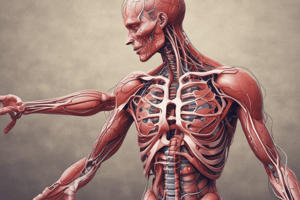Podcast
Questions and Answers
Nhiệm vụ chính của hệ tuần hoàn là gì?
Nhiệm vụ chính của hệ tuần hoàn là gì?
Vận chuyển dưỡng chất cần thiết và khí ôxy = Duy trì cân bằng nội bộ Loại bỏ sản phẩm chất độc hại = Cung cấp khí cacbonic Hỗ trợ chức năng miễn dịch = Phân phối dưỡng chất Duy trì môi trường nội bộ ổn định = Cung cấp muối khoáng
Hệ tuần hoàn thực hiện nhiệm vụ duy trì cân bằng nội bộ như thế nào?
Hệ tuần hoàn thực hiện nhiệm vụ duy trì cân bằng nội bộ như thế nào?
Bằng cách cung cấp ôxy cho tế bào và loại bỏ khí cacbonic = Bằng cách ngăn ngừa vi khuẩn xâm nhập Bằng việc phân phối hormone và enzyme = Bằng việc giữ cho môi trường nước ổn định Bằng việc vận chuyển dưỡng chất và loại bỏ sản phẩm chất độc hại = Bằng việc tạo ra protein miễn dịch Bằng việc tăng cường hấp thụ dưỡng chất từ môi trường = Bằng việc tạo ra axit amin thiết yếu
Môi trường nội bộ ổn định được duy trì như thế nào thông qua hệ tuần hoàn?
Môi trường nội bộ ổn định được duy trì như thế nào thông qua hệ tuần hoàn?
Bằng việc cung cấp muối khoáng và vitamin = Bằng việc loại bỏ khí nitơ Bằng việc duy trì huyết áp ổn định = Bằng việc cung cấp protein miễn dịch Bằng việc vận chuyển dưỡng chất và loại bỏ sản phẩm chất độc hại = Bằng việc kiểm soát lượng glucose trong máu Bằng cách ngăn ngừa sự thay đổi đột ngột trong pH máu = Bằng việc tạo ra axit amin thiết yếu
Hệ tuần hoàn có vai trò quan trọng trong chức năng gì?
Hệ tuần hoàn có vai trò quan trọng trong chức năng gì?
Kết hợp các bộ phận của hệ tuần hoàn với chức năng chính của chúng:
Kết hợp các bộ phận của hệ tuần hoàn với chức năng chính của chúng:
Phân biệt các loại mạch máu với chức năng chính của chúng:
Phân biệt các loại mạch máu với chức năng chính của chúng:
Liên kết các phần của tim với chức năng của từng phần:
Liên kết các phần của tim với chức năng của từng phần:
Flashcards are hidden until you start studying
Study Notes
The Circulatory System in Biology
The circulatory system is a vital component of biological organisms, responsible for transporting oxygen, carbon dioxide, nutrients, and waste products between different parts of the body. It plays a crucial role in maintaining the overall balance and functionality of an organism. This article will discuss the main features of the circulatory system and its impact on biology.
Basic Features of Circulatory Systems
All living organisms require essential nutrients and oxygen for survival. These resources must be transported across the body to ensure proper functioning. The internal environment of each organism varies in terms of its composition and homeostasis maintenance, depending on the species. The circulatory system typically maintains a constant internal environment through specialized fluid and channels called blood vessels.
In vertebrates, there are two primary fluids involved in circulation: blood and lymph. Blood transports essential nutrients, respiratory gases, and waste products throughout the body via a closed system of vessels. It also plays a significant role in maintaining homeostasis by providing oxygen to the cells and removing carbon dioxide as waste. Lymph, on the other hand, is responsible for immunity functions and acts as a secondary circulatory system that helps remove waste products and distribute nutrients.
Human Circulatory System Overview
The human circulatory system consists of three main components: the heart, blood vessels, and blood circulation factors. The heart serves as a pump, delivering blood throughout the body via specialized blood vessels. Blood vessels include arteries, veins, and capillaries, which work together to transport blood to various parts of the body and return it back to the heart.
Heart Function
The heart functions as a pump to circulate blood throughout the body. It has four chambers: two atria on the top and two ventricles on the bottom. Deoxygenated blood enters through the right atrium, passes into the right ventricle, and then moves out through the pulmonary artery to the lungs for oxygenation. Oxygenated blood returns to the left side of the heart and is distributed to the rest of the body via the aorta.
Blood Vessels
Arteries are the primary blood vessels carrying oxygenated blood away from the heart towards tissue. Capillaries, with their thin walls, allow efficient exchange of nutrients, gases, and waste between blood and surrounding tissues. Veins transport blood back to the heart, collecting deoxygenated blood from the tissues and returning it to the heart for re-oxygenation.
Blood Circulation Factors
Several factors regulate blood circulation and help maintain a constant internal environment. These include hormones such as vasopressin and angiotensin II, which can increase blood vessel diameter or constrict them, respectively. Additionally, nerve impulses transmitted through sympathetic neurons affect blood vessels by increasing blood pressure and flow in response to stress or physical activity.
Conclusion
The circulatory system plays a crucial role in maintaining balance within biological organisms by transporting essential nutrients, oxygen, and waste products throughout the body. Understanding its structure and function is vital for studying various aspects of biology, including physiological processes, organ system interactions, and overall homeostasis maintenance.
Studying That Suits You
Use AI to generate personalized quizzes and flashcards to suit your learning preferences.




